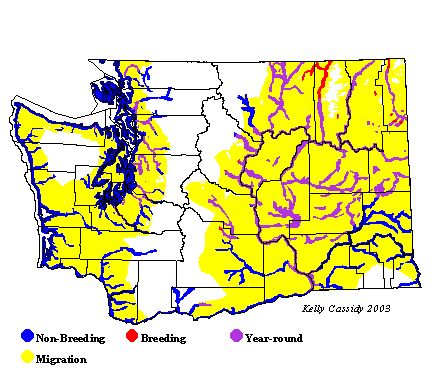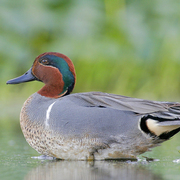Green-winged Teal
General Description
The smallest dabbling duck, the Green-winged Teal is smaller and more compact than other teals and has a round head and narrow bill. All sexes and ages have dark gray wings with green-black speculums and a brown bar above each speculum. Females and juveniles are mottled brown overall with gray legs. Males in breeding plumage have gray bodies with orange-buff, dark-spotted breasts and yellow patches on their flanks. Their rumps are black and buff, and their rufous heads have an iridescent green band swooping back in a curve on each side. They also have a vertical white shoulder-bar on each side, which can be a helpful field mark when trying to distinguish the Green-winged Teal from the Eurasian race.
Habitat
The Green-winged Teal lives in shallow wetlands, preferring fresh water for breeding, but is resident on both fresh and salt water at other times of the year. Nesting habitat usually has trees and shrubs. During winter and migration, wetlands with a lot of emergent and floating vegetation are commonly used. Tidal mudflats are used by this species more often than by any other duck.
Behavior
Green-winged Teals usually gather in smallish flocks, but large flocks of thousands are also seen. Active and agile, they forage in emergent vegetation along shorelines and in wet, shallow, muddy areas, mainly by dabbling their bills at the water's surface. Because of their small size and rapid wing-beats, these birds in flight appear to move very fast.
Diet
The Green-winged Teal's diet is variable depending on season and location, with more animal matter consumed during the spring and summer, and more plants eaten in the fall and winter. Plant matter usually consists of the seeds of grasses, sedges, and pond-weeds. Animal matter is most often insect larvae, other aquatic invertebrates, and sometimes fish eggs.
Nesting
Green-winged Teals usually arrive at the breeding grounds with pair bonds formed. Nests are usually located in grasses and weeds in meadows, open woodlands, or brush, and are usually within two hundred feet of water. The female builds the nest on the ground. It is well hidden by low vegetation that often is dense enough to form a full canopy over the nest. The nest itself is usually a shallow depression, filled with grasses, twigs, and leaves, lined with down. Incubation is by the female alone, and lasts for 20 to 24 days, during which time the pair bond dissolves, and the male leaves the nesting area. Within a few hours of hatching, the 8 to 9 ducklings leave the nest with the female to look for their own food. They may all return to the nest at night for a few days. The young fledge at about 35 days.
Migration Status
Nearly all populations of Green-winged Teal are migratory, although they remain farther north during the winter than other species of North American teal. After incubation begins, the males migrate to molting grounds where they gather and go through a period of flightlessness. The molt migration may be to a spot close by, or may be over one hundred miles away. Fall migration occurs over an extended period, beginning in late August and stretching into early December. Females may move farther south than males. Spring migration usually begins in February and lasts through April. They often migrate over the ocean, sometimes in association with sea ducks.
Conservation Status
With 80% of the North American Green-winged Teal population breeding north of the United States-Canada border, most of the breeding grounds are away from human activity, and thus numbers have remained fairly stable and are even increasing in some areas. In 1990 the population was estimated at over 3,000,000 birds. The Common Teal, or Eurasian Green-winged Teal, a Eurasian subspecies of the Green-winged Teal, is recorded in small numbers in Washington in most years, and sightings have become more common, especially in the late winter and early spring. The increase in sightings may be due to an increase in birds, or an increase in reporting rates due to more birders out there looking for them. The Common Teal is currently considered the same species (although a different subspecies) as the Green-winged Teal in North America. However, British ornithologists recently split the two into different species, and some speculate that the American Ornithologists Union will soon follow their lead.
When and Where to Find in Washington
In western Washington, the Green-winged Teal is a rare breeder around Puget Sound. It is much more familiar as a wintering species, common from September to early May, especially in tidal marshes and flooded fields throughout the lowlands of coastal and western Washington. Most birds seen west of the Cascades during the summer are non-breeders. In eastern Washington, Green-winged Teals breed in the Columbia River Basin and the northern river valleys, especially at the confluence of the Okanogan and Columbia Rivers, Potholes Reservoir (Grant County), and Lake Lenore (Douglas/Grant Counties), and can be found in these and other wetlands with appropriate habitat throughout the year.
 Abundance
Abundance
| Ecoregion | Jan | Feb | Mar | Apr | May | Jun | Jul | Aug | Sep | Oct | Nov | Dec |
|---|---|---|---|---|---|---|---|---|---|---|---|---|
| Oceanic | ||||||||||||
| Pacific Northwest Coast | C | C | C | C | F | R | R | U | C | C | C | C |
| Puget Trough | C | C | C | C | F | R | R | F | C | C | C | C |
| North Cascades | U | U | U | U | R | R | R | R | R | U | U | U |
| West Cascades | C | C | C | C | U | R | R | R | C | C | C | C |
| East Cascades | U | U | U | U | U | R | R | U | F | F | F | U |
| Okanogan | U | U | C | C | C | C | C | C | C | C | C | U |
| Canadian Rockies | U | U | F | F | U | U | U | U | U | U | U | U |
| Blue Mountains | R | U | U | R | R | U | U | U | ||||
| Columbia Plateau | C | C | C | C | C | F | F | F | C | C | C | C |
Washington Range Map

North American Range Map


Family Members
 Fulvous Whistling-DuckDendrocygna bicolor
Fulvous Whistling-DuckDendrocygna bicolor Taiga Bean-GooseAnser fabalis
Taiga Bean-GooseAnser fabalis Greater White-fronted GooseAnser albifrons
Greater White-fronted GooseAnser albifrons Emperor GooseChen canagica
Emperor GooseChen canagica Snow GooseChen caerulescens
Snow GooseChen caerulescens Ross's GooseChen rossii
Ross's GooseChen rossii BrantBranta bernicla
BrantBranta bernicla Cackling GooseBranta hutchinsii
Cackling GooseBranta hutchinsii Canada GooseBranta canadensis
Canada GooseBranta canadensis Mute SwanCygnus olor
Mute SwanCygnus olor Trumpeter SwanCygnus buccinator
Trumpeter SwanCygnus buccinator Tundra SwanCygnus columbianus
Tundra SwanCygnus columbianus Wood DuckAix sponsa
Wood DuckAix sponsa GadwallAnas strepera
GadwallAnas strepera Falcated DuckAnas falcata
Falcated DuckAnas falcata Eurasian WigeonAnas penelope
Eurasian WigeonAnas penelope American WigeonAnas americana
American WigeonAnas americana American Black DuckAnas rubripes
American Black DuckAnas rubripes MallardAnas platyrhynchos
MallardAnas platyrhynchos Blue-winged TealAnas discors
Blue-winged TealAnas discors Cinnamon TealAnas cyanoptera
Cinnamon TealAnas cyanoptera Northern ShovelerAnas clypeata
Northern ShovelerAnas clypeata Northern PintailAnas acuta
Northern PintailAnas acuta GarganeyAnas querquedula
GarganeyAnas querquedula Baikal TealAnas formosa
Baikal TealAnas formosa Green-winged TealAnas crecca
Green-winged TealAnas crecca CanvasbackAythya valisineria
CanvasbackAythya valisineria RedheadAythya americana
RedheadAythya americana Ring-necked DuckAythya collaris
Ring-necked DuckAythya collaris Tufted DuckAythya fuligula
Tufted DuckAythya fuligula Greater ScaupAythya marila
Greater ScaupAythya marila Lesser ScaupAythya affinis
Lesser ScaupAythya affinis Steller's EiderPolysticta stelleri
Steller's EiderPolysticta stelleri King EiderSomateria spectabilis
King EiderSomateria spectabilis Common EiderSomateria mollissima
Common EiderSomateria mollissima Harlequin DuckHistrionicus histrionicus
Harlequin DuckHistrionicus histrionicus Surf ScoterMelanitta perspicillata
Surf ScoterMelanitta perspicillata White-winged ScoterMelanitta fusca
White-winged ScoterMelanitta fusca Black ScoterMelanitta nigra
Black ScoterMelanitta nigra Long-tailed DuckClangula hyemalis
Long-tailed DuckClangula hyemalis BuffleheadBucephala albeola
BuffleheadBucephala albeola Common GoldeneyeBucephala clangula
Common GoldeneyeBucephala clangula Barrow's GoldeneyeBucephala islandica
Barrow's GoldeneyeBucephala islandica SmewMergellus albellus
SmewMergellus albellus Hooded MerganserLophodytes cucullatus
Hooded MerganserLophodytes cucullatus Common MerganserMergus merganser
Common MerganserMergus merganser Red-breasted MerganserMergus serrator
Red-breasted MerganserMergus serrator Ruddy DuckOxyura jamaicensis
Ruddy DuckOxyura jamaicensis

